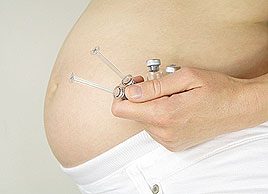How to treat gestational diabetes
Diabetes that develops in pregnancy, or "gestational diabetes." Learn if you’re a risk, if you should be tested and how to treat this complication

One of the most common complications during pregnancy, gestational diabetes (GD) is a condition that develops during the second trimester. According to Lisa Weston, registered midwife and vice president of the Association of Ontario Midwives, 3 to 4 percent of pregnant women develop this condition.
Diagnosis of gestational diabetes
During pregnancy, the placenta produces hormones that block the effects of insulin, making the mother insulin resistant. This insulin resistance is usually noticeable around the 20 to 24 weeks of pregnancy when the high blood sugar in the mother’s blood stimulates the baby to make more insulin. Extra sugar is then absorbed by the baby, causing extra weight gain.
Testing
The risk of gestational diabetes is greater in women who have a body mass index over 30, are over 30 years of age, have a history of gestational diabetes or large babies, or have a family history of diabetes. According to Weston, women of aboriginal, Hispanic, Asian, South Asian, and African descent also have a higher risk of developing GD. ‘There is also a greater chance for women who have had it in a previous pregnancy or have had a very large baby,’ says Weston. She recommends that women with more than one risk factor be tested for GD during the first three months of pregnancy and reassessed in the next two trimesters.
Women can be screened for GD between 24 and 28 weeks’ gestation using a gestational diabetes test called the oral glucose tolerance test. The test itself is simple ‘ oral glucose is ingested and an hour later, a woman’s blood sugar levels are measured. If the blood sugar is above the recommended range, the test will be administered again with a large amount of oral glucose. If the blood sugar levels are still above the recommended range, a diagnosis of GD will be made.
According to Weston, there is still no clear evidence that all women should be screened for gestational diabetes and many health care providers do not screen women who have no risk factors. There is also no consensus on the risks associated with GD. “The main concern with gestational diabetes is that babies can grow larger than they would otherwise and could have a harder time being born vaginally,’ explains Weston. Sometimes babies can develop problems with their own sugar levels after birth, requiring on-going monitoring and sometimes treatment.
Treatment
‘Women who are diagnosed with gestational diabetes are referred to a diabetes education centre to learn about diet and how the body uses the food that it is given,’ says Weston. ‘They learn about the diabetic diet, exercise and how to test their blood sugars. Many women are able to keep their blood sugars in the normal range with diet and exercise alone, and are at lower risk for ongoing complications.’ Insulin therapy may be recommended for women with blood sugar levels that don’t stabilize. ‘An endocrinologist will help these women manage their gestational diabetes,’ Weston says.
Although GD doesn’t have any noticeable symptoms, some women may notice excessive thirst, blurred vision, extreme tiredness (more than the normal pregnancy fatigue) and having to urinate frequently.
After the birth of their baby, Weston recommends that women who developed gestational diabetes during pregnancy get tested after 6 to 12 weeks to make sure they don’t have any ongoing problems.




